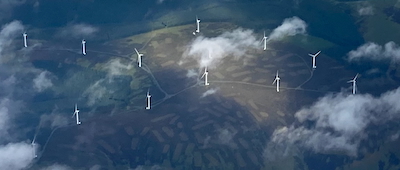
Community Council
of the Royal Burgh of Peebles & District

Community Council
of the Royal Burgh of Peebles & District
South of Scotland communities have benefitted from £30.9 million funding from onshore wind farms since 1996. That figure could triple to almost £900 million by 2058 if the South’s share remains at the current level of 21% of Scotland’s onshore wind generation capacity [SOSE, pp 1-2].
Those community benefits payments are made to local communities hosting wind farm and electricity generation networks and are paid in various forms. Community benefit funds are generally fixed annual amounts paid to communities who then allocate funding to local projects. However, shared ownership or in-kind benefits, such as electricity bill discounts to residents or direct funding of larger community projects, can also be offered.
Expectations were set in 2014 that onshore wind farms should contribute to local economies:
“Scottish Government recommends a community benefit package for onshore wind developments with a value to the equivalent of at least £5,000 per installed megawatt per annum,
Sadly, the
Crossdykes Wind Farm near Lockerbie is hailed as industry leading after committing to £7000 per MW per year.
After
Of the 21 proposed new wind farm projects for the South of Scotland that are likely to proceed, the average value of community benefits funds is estimated at £3986 per MW per year. While this is substantially higher than the current average benefits paid by existing wind farms of £2537 per MW per year, this is still less than 60% of the Crossdykes figure and the guidance [SOSE, page 23].
The Scottish Government introduced guidance on community benefits rather than legislation because of the UK parliament’s decision to reserve energy policy. In December 2023, Scottish Minister for Energy & Environment Gillian Martin wrote to UK Secretary of State for Energy Security and Net Zero Claire Coutinho:
“The Cabinet Secretary and I have consistently called on the UK Government to explore mandating community benefits for onshore energy developments. I am writing to reiterate that call.” [HoCL, pg 7]
Rt Hon Mr Angus MacDonald in his maiden speech at Westminster 5 Sep 2024 said:
“What was a beautiful view of the mountains is now rows of 200-metre-high whirling turbines, and large new pylons marching across the country to the cities, where the demand is. Secondly, what is in it for the locals? The turbines and generators are manufactured overseas, the developer and utilities firms are from outwith the UK, and the workers are shipped in. Last year, our total community benefit from that multibillion-pound industry was an estimated £9.1 million in the highlands, and £26.4 million across Scotland as a whole. It should be a multiple of those figures. ...
What can be done about this? I propose that 5% of revenue from all newly consented renewable energy generated both onshore and offshore should be paid to community benefit funds. For onshore projects, two thirds of that should be paid to the affected council ward, with one third paid to a council infrastructure fund. ...
The Norwegians handled the revenue from the North sea oil boom well, and their sovereign wealth fund is now valued at $1.7 trillion. Britain saved nothing, and we are in real danger of repeating that mistake with the renewables bonanza.” [Hansard. Note Follow-on debate 15 Oct 2024]

Bowbeat Wind Farm (pictured, in the north of the Peebles and Innerleithen District Community Council areas) recently had its lifetime extended by SBC by 5 years.
If you have any thoughts on community benefits from this or other wind farms, please contact Anne Snoddy (Secretary) secretary@ccrbpeebles.co.uk
Dr Michael Marshall
Planning Convenor
Peebles and District Community Council